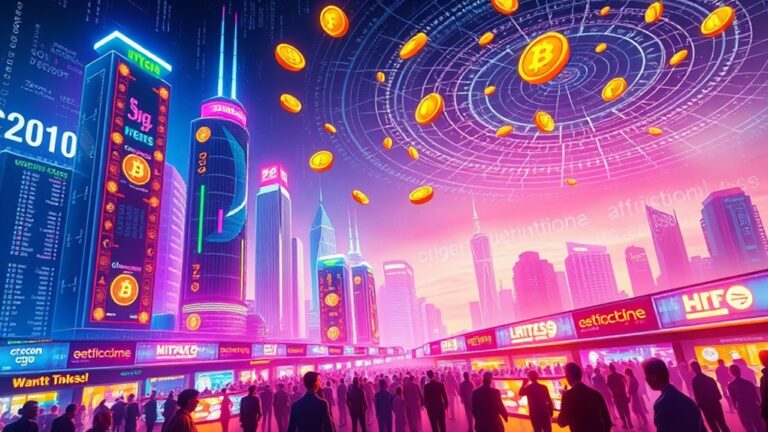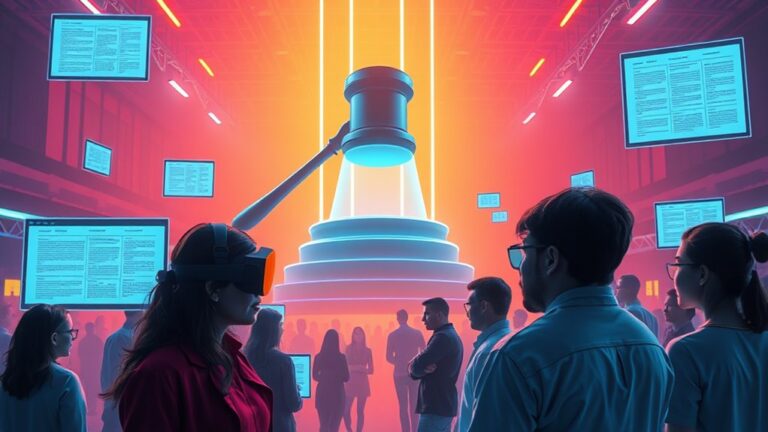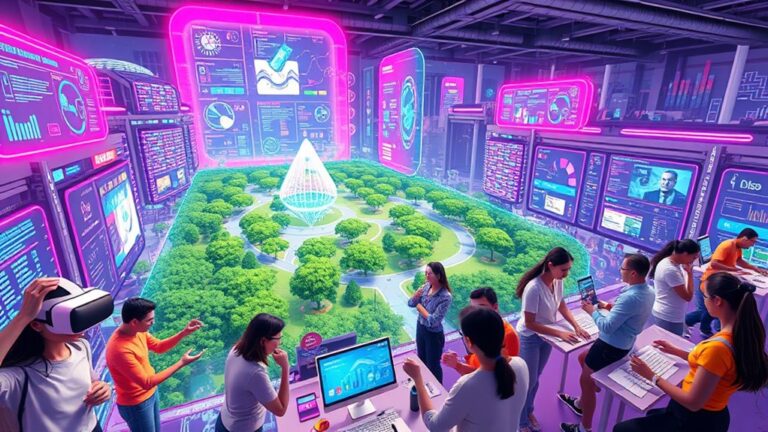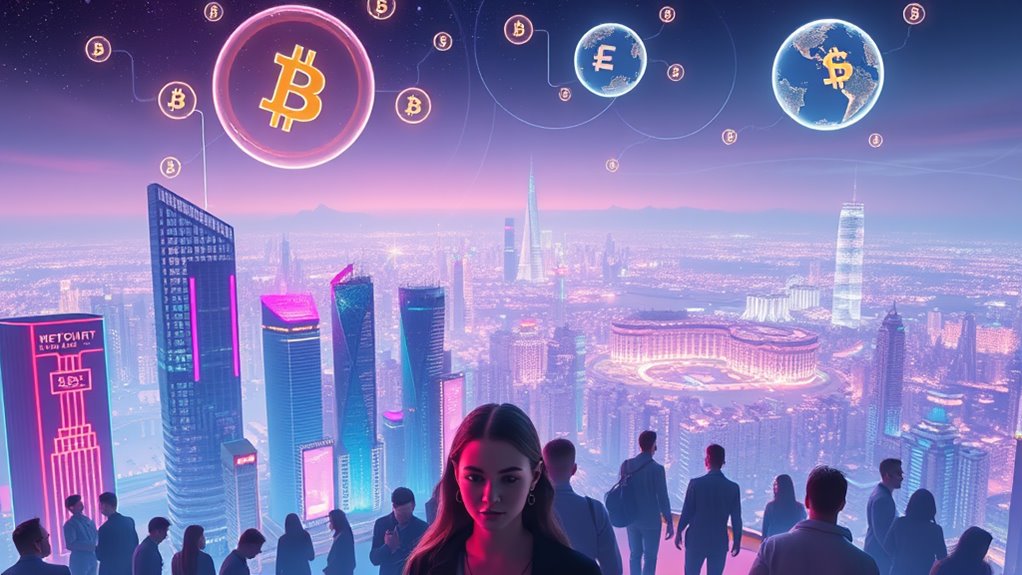
The Metaverse: What It Means for Cryptocurrency and Beyond
The metaverse is an evolving digital environment that markedly influences cryptocurrency usage and blockchain technology. It enables secure and efficient virtual transactions through cryptocurrencies, enhancing real-time interactions and asset exchanges. Blockchain serves as the essential infrastructure, ensuring transparency and reducing fraud risks in virtual economies. Decentralized systems promote user empowerment, enabling individuals to control their digital assets. The metaverse presents new investment opportunities and faces various challenges, shaping its future and impact on traditional finance. Further insights await.
Key Takeaways
- The metaverse utilizes cryptocurrencies for secure, efficient transactions, enabling global exchanges of virtual assets with reduced intermediaries.
- Blockchain technology ensures transparency and immutability in virtual economies, fostering trust and reducing fraud risks.
- Decentralized platforms empower users by allowing control over data and privacy, while encouraging community-driven moderation and economic participation.
- The integration of NFTs in the metaverse solidifies digital asset ownership, creating investment opportunities in virtual real estate and collectibles.
- Future trends in the metaverse, such as decentralized finance, may disrupt traditional banking systems, lowering costs and enhancing transaction speeds.
Understanding the Metaverse: A New Digital Frontier
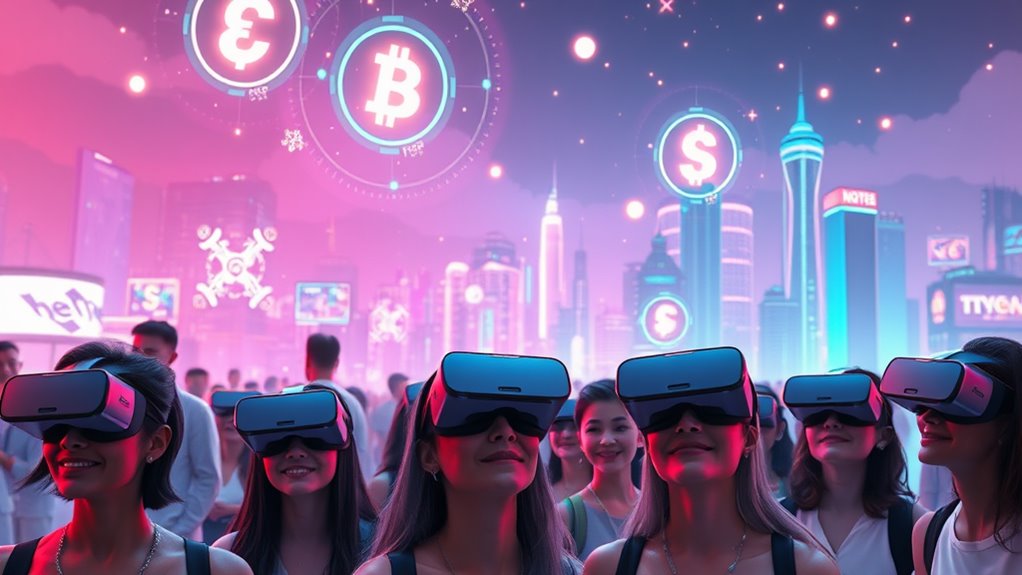
As technology continues to advance, the metaverse emerges as a new digital frontier that transforms how individuals interact with one another and engage with their environments.
This expansive, interconnected digital world encompasses virtual reality (VR), augmented reality (AR), and blockchain technology, allowing users to experience immersive and decentralized environments.
The metaverse represents an evolution of the internet by blending physical and digital realities. Key features include real-time interactivity and user agency, which enable diverse platforms and devices to function seamlessly together.
Technologies like AI, cloud computing, and advanced 5G networks underpin these experiences, making the metaverse accessible and engaging.
As it continues to develop, the metaverse holds the potential to greatly reshape social interactions and business landscapes.
The Role of Cryptocurrencies in Virtual Economies
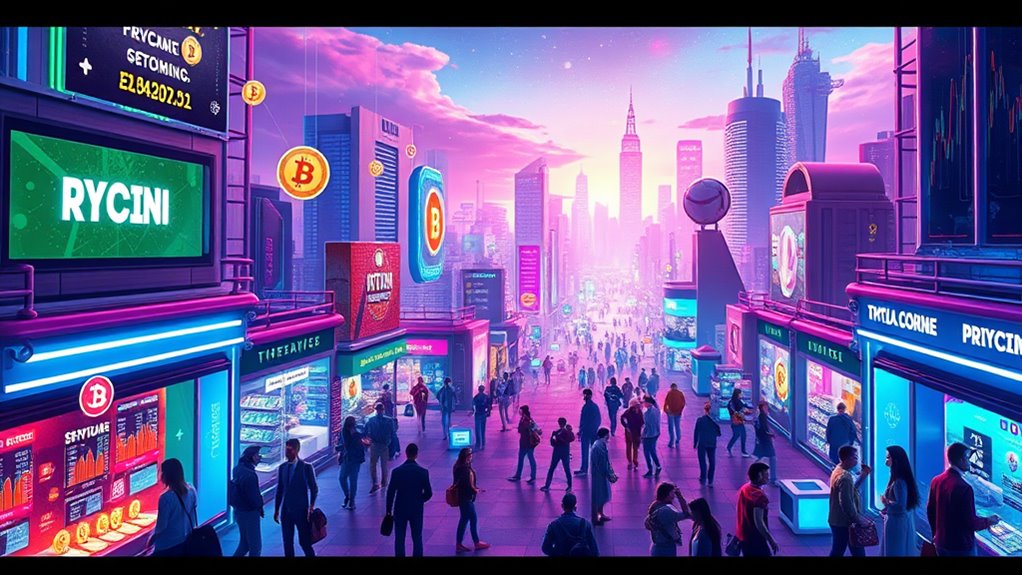
Cryptocurrencies play an essential role in the functioning of virtual economies within the metaverse, as they provide both a secure and efficient means for users to engage in transactions. They facilitate fast, global exchanges of virtual assets, minimizing the need for intermediaries and associated fees.
Additionally, smart contracts automate transactions, ensuring that agreements are executed without third-party involvement. Cryptocurrencies are critical for purchasing virtual real estate, digital collectibles, and other unique assets.
Moreover, decentralized finance (DeFi) services enhance financial opportunities, allowing users to lend and stake digital assets. By establishing trust and transparency, cryptocurrencies contribute greatly to the growth of virtual economies, creating new avenues for income and enhancing user experiences across different metaverse platforms. This integration of decentralized finance not only improves accessibility but also fosters a more inclusive financial ecosystem within the metaverse.
Blockchain Technology: The Backbone of the Metaverse

Blockchain technology serves as the fundamental backbone of the metaverse, providing essential features that enhance its functionality and security. It operates on a decentralized system, ensuring transparency and immutability of transactions, which greatly reduces fraud risks. Smart contracts automate processes, improving efficiency by eliminating intermediaries. The interoperability of blockchain allows for seamless asset transfers between different platforms within the metaverse. Additionally, the integration of decentralized, immutable digital ledger technology facilitates secure and verifiable interactions among users.
| Feature | Description | Benefit |
|---|---|---|
| Decentralization | Distributed ledger across multiple nodes | Enhanced security |
| Immutability | Permanent transaction records | Reduced fraud |
| Smart Contracts | Automated agreements and transactions | Increased efficiency |
This integration of blockchain technology fosters trust and offers users greater control over their digital assets in the evolving metaverse landscape.
Decentralization and User Empowerment in Digital Spaces
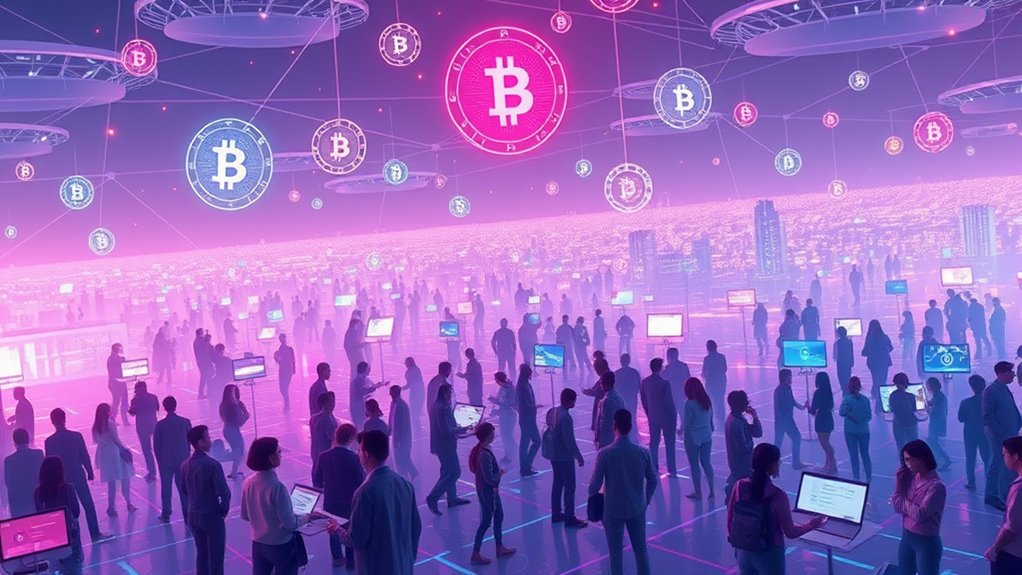
The integration of decentralized technologies in digital spaces has transformed the way users interact with online platforms, promoting empowerment and autonomy.
Decentralized technologies have revolutionized online interactions, fostering user empowerment and greater autonomy in digital spaces.
Decentralized platforms allow users to control their data and privacy, reducing the risk of exploitation. Algorithmic transparency enables individuals to personalize content delivery, minimizing manipulation by unseen algorithms.
Communities flourish on platforms like Mastodon, where niche groups can form, fostering genuine interactions. Economic incentives, such as cryptocurrency rewards on platforms like Steemit, encourage user participation and value sharing.
Additionally, community-driven moderation practices lessen corporate control, enhancing trust among users. Overall, decentralization empowers individuals, creating more inclusive and secure environments for digital engagement, while also promoting direct economic participation through decentralized models. Furthermore, the rise of smart contracts has enabled innovative applications that enhance user interactions and trust within these decentralized spaces.
Investment Opportunities Within the Metaverse
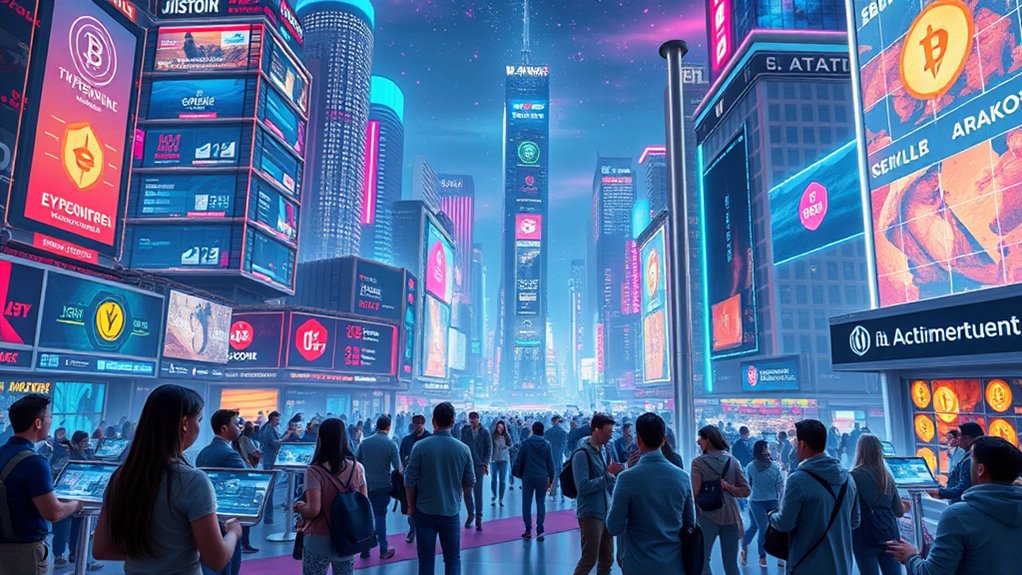
Investment opportunities within the Metaverse are expanding, particularly through virtual real estate and NFTs.
Virtual land can appreciate in value and be developed into income-generating properties, while NFTs provide a method for establishing ownership of digital assets.
As interest in these avenues grows, investors must consider the potential rewards alongside the inherent risks of this emerging market.
Virtual Real Estate Ventures
Exploring virtual real estate ventures within the metaverse reveals a landscape rich with opportunities for investors.
Key platforms like Decentraland and The Sandbox allow users to buy and develop virtual land, creating avenues for land development and rental income. Investors can monetize properties through events or brand engagements, capitalizing on the growing demand for unique digital experiences.
The finite supply of virtual land drives value, while cryptocurrency transactions streamline purchases. However, challenges such as regulatory uncertainty and market volatility persist.
As the metaverse market expands, strategic partnerships and advancements in technology are expected to enhance the appeal of virtual real estate, making it an intriguing area for investment in the digital economy.
NFT Investment Potential
As the Metaverse continues to evolve, the potential for NFT investments has become increasingly apparent. The NFT market within the Metaverse is projected to reach USD 3,078.7 million by 2033, driven largely by advancements in augmented reality (AR) and virtual reality (VR) technologies.
NFTs offer high interoperability, allowing assets to be utilized across various platforms. This capacity creates new revenue streams for creators and investors alike. Investment opportunities extend beyond traditional real estate, encompassing digital fashion, virtual art, and gaming assets.
Additionally, global brands are increasingly leveraging NFTs for innovative marketing strategies. NFTs are created through a process called minting, which involves encrypting the asset’s information and recording it on a blockchain. However, investors should be mindful of cybersecurity risks and the evolving regulatory environment that may impact NFT valuations and transactions in the future.
Challenges Facing the Metaverse and Its Economies
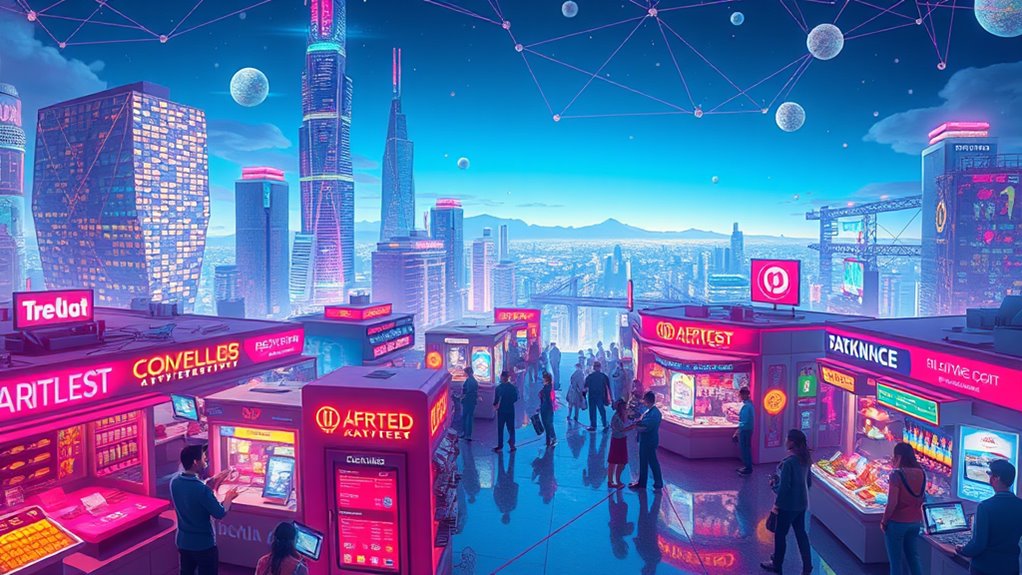
The Metaverse faces several significant challenges that could impact its growth and functionality.
Security risks, such as data breaches and identity theft, pose threats to user privacy and digital assets.
Additionally, regulatory uncertainties and the need for compliance can create confusion, while interoperability between different platforms remains a technical hurdle that hinders seamless user experiences.
Security Risks and Threats
Security risks and threats in the Metaverse present significant challenges that can undermine user trust and the stability of its economies.
Phishing scams, often using realistic 3D avatars, deceive users into revealing sensitive information. Malware can compromise devices, allowing unauthorized access to personal data and virtual identities.
Additionally, the anonymity of avatars can lead to identity theft, with profiles impersonated for malicious purposes. Cryptocurrency wallets and NFTs are frequent targets for hackers, exploiting vulnerabilities in smart contracts and fraudulent messaging.
Furthermore, the collection of biometric data raises privacy concerns, as users may struggle to control their information.
These threats require robust cybersecurity measures, including encryption and regular security audits, to protect users and their assets effectively.
Regulatory Uncertainties and Compliance
Regulatory uncertainties and compliance issues pose significant challenges for the metaverse and its evolving economies, particularly as they intersect with the security risks previously discussed.
The absence of standardized legal frameworks complicates regulation, making it difficult for companies and individuals to guarantee compliance with data privacy and intellectual property laws. Emerging technologies like blockchain and AI necessitate adaptable regulatory approaches.
Jurisdiction-based differences further complicate enforcement efforts. Intellectual property rights, contract law, and defamation laws are vital in protecting users and creators within this digital space.
Additionally, the taxation of virtual assets introduces complexities that require clear reporting mechanisms. Overall, a collaborative effort between tech companies and regulators is important to establish effective standards for a legally compliant metaverse. Moreover, as seen with crypto regulations that focus on consumer protection, similar frameworks could emerge to safeguard users in the metaverse.
Interoperability Between Platforms
Interoperability between platforms represents a significant challenge for the development of the metaverse and its economic potential. The lack of common standards, vendor-centric platforms, and differing technical architectures complicate asset transfers and seamless interactions.
| Challenges | Implications |
|---|---|
| Technical Differences | Hinders unified user experiences |
| Vendor-Centric Metaverses | Limits asset portability |
| Lack of Standards | Affects transaction efficiency |
Additionally, integrating diverse data types and competing forums further complicate standardized solutions. However, foundational technologies like blockchain, NFTs, and Information-Centric Networking offer potential pathways to enhance interoperability. As these innovations develop, they could facilitate significant market growth and improve consumer engagement within the metaverse economy.
Future Trends Shaping the Metaverse Experience

As the Metaverse continues to evolve, several future trends are expected to greatly shape the user experience within this digital landscape.
The integration of advanced technologies and innovative applications will redefine how users interact and engage. Key trends include:
- Metaverse gaming will offer immersive experiences and play-to-earn models, enhancing user engagement.
- Augmented reality (AR) will blend virtual elements with the real world, creating seamless interactions.
- Artificial intelligence (AI) will improve avatar realism and enable more interactive non-player characters (NPCs), enriching user experiences.
- Non-fungible tokens (NFTs) will play an essential role in virtual economies, solidifying ownership of digital assets.
These trends highlight a transformative future, aiming to create a more interconnected and engaging Metaverse experience for users across various sectors.
The Interplay Between Web 3.0 and the Metaverse
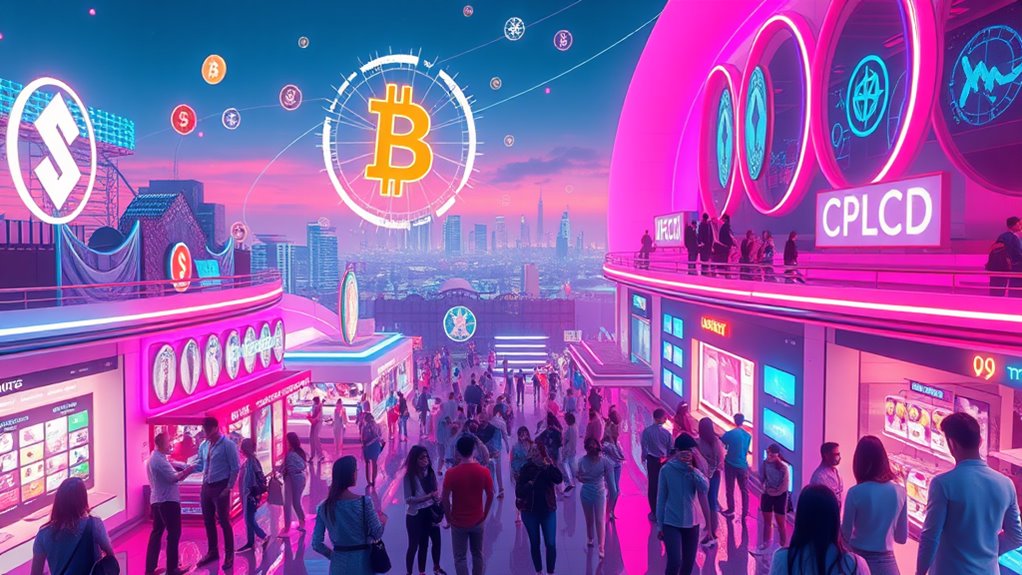
The Metaverse and Web 3.0 are interconnected spheres that share a foundation in decentralized technologies, shaping how users interact with digital environments. Both platforms utilize blockchain technology, promoting secure transactions and community-driven governance, which enhances user control over digital assets.
In Web 3.0, users manage their data autonomously, while the Metaverse focuses on immersive experiences through virtual reality and augmented reality. Interoperability is a key feature, allowing users to transport their avatars and assets across different platforms. However, achieving seamless integration remains a challenge.
As both ecosystems evolve, they rely on active community participation for development, fostering a shared landscape where digital ownership and decentralized marketplaces thrive. Ultimately, this transformation enhances user experiences in the digital sphere.
The Impact of the Metaverse on Traditional Financial Systems

Although the metaverse offers innovative avenues for financial interactions, its impact on traditional financial systems is significant and multifaceted. The emergence of decentralized finance and digital currencies challenges established banking practices, shaping a new economic landscape.
Key aspects include:
- Decentralized Transactions: Peer-to-peer interactions reduce reliance on banks, lowering costs and time.
- Virtual Banking Branches: Financial institutions are considering virtual branches to enhance global accessibility.
- Blockchain Technology: This technology increases security and transparency in transactions.
- Regulatory Challenges: The metaverse introduces concerns regarding cybersecurity and compliance, necessitating new regulations.
As consumer behaviors shift towards digital currencies and virtual economies, traditional financial systems must adapt to maintain relevance in this evolving environment. Furthermore, the rise of decentralized exchanges allows users to engage in trading without relying on intermediaries, further disrupting traditional finance.
Frequently Asked Questions
How Do I Start Investing in Virtual Real Estate?
To start investing in virtual real estate, one must set up a digital wallet, choose a metaverse platform, conduct thorough market research, and determine suitable strategies for purchasing and managing digital assets securely.
What Are the Best Cryptocurrencies for Metaverse Transactions?
The best cryptocurrencies for metaverse transactions include Decentraland (MANA), The Sandbox (SAND), and Axie Infinity (AXS), as they facilitate various in-game economies, digital ownership, and seamless cross-platform transactions, enhancing user experiences and engagement.
How Can I Create and Sell NFTS in the Metaverse?
To create and sell NFTs in the metaverse, one must utilize NFT platforms, secure digital wallets, and leverage marketplaces for transactions, ensuring quality and demand while maneuvering potential market risks and technical challenges.
What Skills Are Needed to Develop Metaverse Applications?
To develop metaverse applications, one needs skills in programming languages like C++, Python, and C#, alongside expertise in VR/AR development, blockchain technologies, data analysis, cybersecurity, and user experience design for immersive and secure environments.
How Does User Identity Work in the Metaverse?
User identity in the metaverse hinges on decentralized identifiers and self-sovereign identity, allowing individuals to manage their credentials securely. This framework promotes privacy, trust, and seamless interoperability across various digital platforms and experiences.
Conclusion
In summary, the metaverse represents a significant evolution in digital interaction, blending virtual realities with economic systems. As cryptocurrencies and blockchain technology support these new environments, questions arise about their long-term viability. Will the metaverse redefine how we engage with digital content and conduct transactions? Understanding these developments is essential for steering the future landscape of virtual economies. As we explore this new frontier, the implications for users, investors, and traditional finance systems remain profound and complex.

